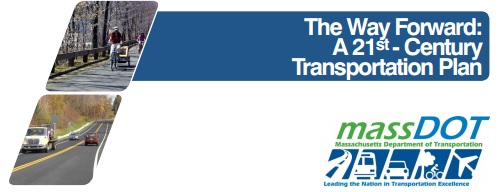Above: Some of the Main Street reconstruction details many residents object to are part of massDOT’s push to increase pedestrians and bicyclists road usage throughout the state. (Image cropped from MassDOT’s 21st Century Transportation Plan)
Last night, MassDOT held a public hearing on the Main Street reconstruction project. Just over 60 residents were in attendance to hear and/or be heard.
Senior Project Manager Carrie E. Lavallee informed the audience that MassDOT’s next step will be to work with the engineers to try to incorporate comments. They will then hold a meeting to inform the public on decisions and changes.
Comments considered will be the ones made last night or postmarked within 10 days after the hearing. To mail comments, use the last 2 pages of the MassDOT public hearing form. (Click here to open the pdf.)
Many from the audience addressed Lavallee with questions and opinions. A common ground was the heroic efforts of the Main Street Design Working Group.
This week the group completed a report detailing recommended changes to the project. The report was endorsed by most commenters, ranging from Bill Boland to David Parry. (Board of Selectman Chair Bill Boland has long been a strong advocate of the plan, while David Parry has been a very vocal critic.)
According to Boland, next week the BOS will meet to vote and adopt the final version of that report. They will then submit the report to MassDOT within the 10 days.
Some specific recommendations were pushed by residents.
One was the insertion of a grass strip between the granite curb and asphalt sidewalk. Working Group Chair Marty Healey urged it as important for keeping the rural look of the area.
As the mother of young children, Nancy O’Conner argued that it is a critical safety feature. When her children rush up the Main Street sidewalk on scooters while cars are speeding by, she is grateful for that grass buffer.
Pressed by Parry, Lavallee responded that they would need to look at right of way constraints and also mentioned utility pole considerations.
Lavallee was asked if there could be changes made to mitigate effect on the Common. She stated that the state had already compromised with inclusion of a share the road lane there. She explained that massDOT has been moving towards even bigger shoulders and travel lanes. It is part of an initiative to increase pedestrian and bicyclists using the roads.
Parry said that he strongly endorses the Working Group report and urged MassDOT to use the recommendations. Still he said he was conflicted and nervous about the plan. He supported an earlier statement that a locally funded alternative plan should be considered.
That has long been Parry’s public view (and stated purpose of his failed article at Town Meeting this April.) Earlier in the night, the issue was raised by Working Group member Steve Phillips.
Phillips, representing himself as a resident, said the Working Group was only charged to see how it could improve the state plan. They were never given the opportunity to assess an alternative, locally funded version.
Phillips pointed out that the town has access to state Chapter 90 funds that could allow immediate work to begin. He stated that smart traffic lights could quickly improve the intersection. He argued that delayed green lights to allow turning would be cheaper, quicker and better than adding four turning lanes.
Lavallee responded that Phillips was right about the money being available, though she didn’t know how much. She clarified that the federal money would not be available. And she reminded that for use of state funds, engineers would still have to approve a plan as safe.
Some residents simply argued for the project to go away. John Butler reiterated statements from his letter to the editor yesterday. One argument about the town’s liability for excess cost was partially refuted.
Lavallee clarified that some cost overruns could be at the town expense. Those are limited to specific items by contract. If the town’s design has errors which cause expenses to exceed 110% of a bid contract, the town is liable for the overrun. She promised to report back on figures from some of her other state projects.
A resident inquired why there were no traffic calming measures, like speed bumps. VHB engineers argued that it is up to the town to first show real enforcement efforts before traffic calming features are inserted.
Another resident argued that unless the state plan comes with an additional police officer, enforcement won’t increase. He pointed to the town’s small force and attention required by Route 9. At a recent Working Group meeting, Captain Paulhous defended lack of enforcement with the same argument.
Karen Muggeridge told Lavallee that she and other in the community support the project. She said that people she knows who live by Fay School want increased safety measures included in the plan, but are uncomfortable speaking in front of project critics.
The meeting was recorded by Southborough Access Media. It wasn’t uploaded yet at the time of writing this post. You can check there later for the video.
Updated (6/19/14 4:45 pm) SAM posted the video here.


